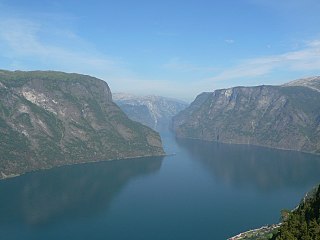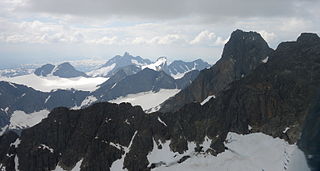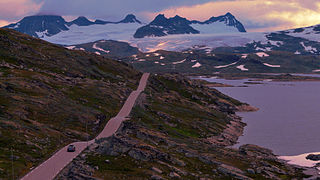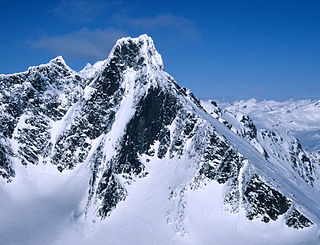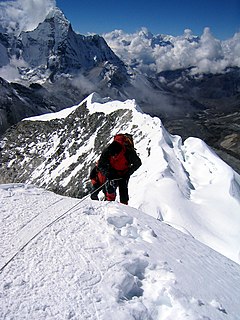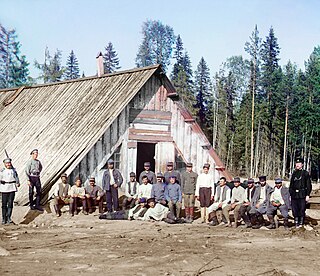
Årdal is a municipality in Sogn og Fjordane county, Norway. It is located at the end of the Årdalsfjorden in the traditional district of Sogn. The village of Årdalstangen is the administrative center of the municipality. The other main village is Øvre Årdal. The municipality of Årdal was created in 1860 when it was separated from the municipality of Lærdal.

Lom is a municipality in Oppland county, Norway. It is part of the traditional region of Gudbrandsdal. The administrative centre of the municipality is the village of Fossbergom. The municipality of Lom was established on 1 January 1838. The area of Skjåk was separated from Lom to become a municipality of its own in 1866.

The Sognefjord or Sognefjorden, nicknamed the King of the Fjords, is the largest and deepest fjord in Norway. Located in Sogn og Fjordane county in Western Norway, it stretches 205 kilometres (127 mi) inland from the ocean to the small village of Skjolden in the municipality of Luster. The fjord takes its name from the traditional district of Sogn, which covers the southern part of the county.

Store Styggedalstind, is the fourth-highest summit in Norway, located within the Hurrungane mountains, which are part of the Jotunheimen mountain range. The mountain is located in the eastern part of the municipality of Luster in Sogn og Fjordane county, Norway. This mountain is directly between the mountains Sentraltind and Jervvasstind.

Skarstind is a prominent part of the Galdhøpiggen mountain range in northwestern Jotunheimen, Norway, and is the sixth highest summit in the country. The mountain has three summits, the main summit at 2,373 meters above sea level, Nåle, the Needle, at 2,310 m and the small western summit at 2,215 m. It is located within the municipality of Lom, on the eastern side of the Leirdalen valley, and the summit can be seen from the road along the valley floor. There are several other peaks in the vicinity, but only Galdhøpiggen, a few kilometers to the east, is higher. The mountain can be seen from most of the higher peaks in Jotunheimen and Breheimen to the northwest.
Andreas Holmsen was a Norwegian historian. author and educator. He is most commonly associated with his textbook, Norges historie fra de eldste tider til 1660, which is a standard introduction in the early Norwegian history.
In 1910 Haakon VII serves his sixth year as King of Norway. On 1 February Wollert Konow takes over as Prime Minister after Gunnar Knudsen, who has held this position since 1908.
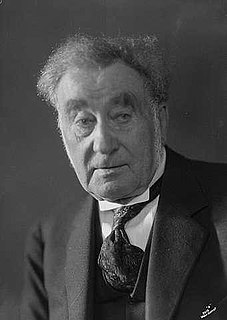
Ola Thommessen was a Norwegian newspaper editor. He was the long-time editor of Verdens Gang and Tidens Tegn.

Arvid Gilbert Hansen was a Norwegian newspaper editor and politician for the Labour and Communist parties.
Ivar Tveit was a Norwegian newspaper editor.
Lom prisoner of war camp was a facility used by the Norwegian 2nd Division to hold German prisoners-of-war during the 1940 Norwegian Campaign of the Second World War. The camp, which operated from 20 to 27 April 1940, also held Norwegians accused of collaborating with the Germans or the Norwegians fascists led by Vidkun Quisling.
Sogn Avis is a Norwegian newspaper, published in Leikanger in Sogn og Fjordane county. It was named Sogns Avis from 1926 to 1972 and Sogningen/Sogns Avis from 1972 to 1993.
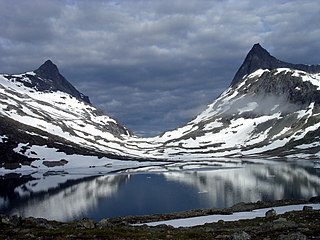
Hjelledalstind is a mountain in the municipality of Årdal in Sogn og Fjordane county, Norway, in the Jotunheimen mountain range.

Kari Skjønsberg was a Norwegian academic, writer and feminist.
Alf Bonnevie Bryn was a Norwegian patent engineer, mountaineer, golf player, novelist and non-fiction writer.

Carl Wilhelm Rubenson was a Swedish-born Norwegian mountaineer and non-fiction writer.
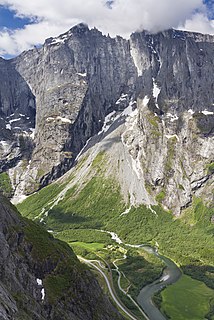
Arne Randers Heen was a Norwegian mountain climber and member of the Norwegian resistance during World War II.

